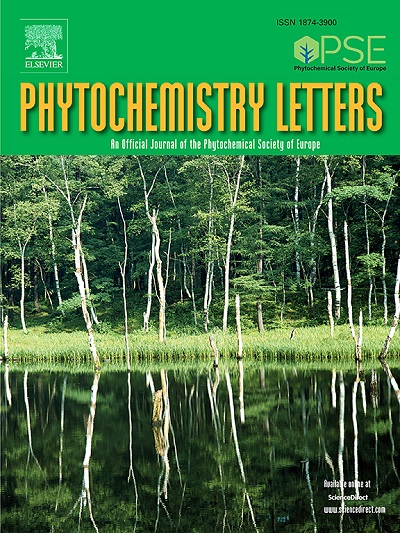For each concentration gradient, two new compounds from the root bark of Acanthopanax gracilistylus and their inhibitory effects on neutrophil elastase, cyclooxygenase-1, and cyclooxygenase-2 in vitro
IF 1.4
4区 生物学
Q4 CHEMISTRY, MEDICINAL
引用次数: 0
Abstract
Rheumatism encompasses a broad spectrum of diseases with complex clinical manifestations, imposing a significant burden on human health. Acanthopanacis cortex, derived from the dried root bark of Acanthopanax gracilistylus W. W. Smith, has been utilized in the treatment of rheumatic diseases in China for more than 2000 years. In this study, two novel compounds (designated as 1 and 2) and twelve previously known compounds (3–14) were firstly isolated from Acanthopanacis cortex. Compound 1 exhibits an unique conjugation of a dibenzylbutane-type lignan with quinic acid by acylation, which structure that has not been previously reported. In the present study, the absolute configuration of 1 was ascertained through the application of DP4 + probabilistic analysis and electronic circular dichroism (ECD) spectroscopy. Furthermore, a comprehensive evaluation of the inhibitory potential of compounds 1 and 3–14 against two key therapeutic targets - neutrophil elastase (NE) and cyclooxygenase-2 (COX-2) - was conducted. Related results indicate that thirteen compounds exhibit more potent inhibitory effects against COX-2, with IC50 values spanning a concentration range of 0.17–32.9 μM. Compound 1 showed a superior inhibition of both COX-2 and NE. These findings offer valuable insights for the pursuit of natural, selective COX-2 inhibitors.
在不同浓度梯度下,研究了粗五加根皮中两种新化合物对中性粒细胞弹性酶、环氧合酶-1和环氧合酶-2的体外抑制作用
风湿病包括广泛的疾病,具有复杂的临床表现,对人类健康造成重大负担。棘五加皮是由棘五加(Acanthopanax gracilistylus W. W. Smith)的干根树皮提取而成,在中国用于治疗风湿性疾病已有2000多年的历史。本研究首次从棘五加皮层中分离到2个新化合物(命名为1和2)和12个已知化合物(3 ~ 14)。化合物1表现出一种独特的二苄基丁烷型木脂素与奎宁酸的酰化偶联,这种结构以前没有报道过。在本研究中,通过DP4 + 概率分析和电子圆二色(ECD)光谱确定了1的绝对构型。此外,综合评价了化合物1和3-14对两个关键治疗靶点-中性粒细胞弹性酶(NE)和环氧化酶-2 (COX-2) -的抑制潜力。结果表明,13种化合物对COX-2具有较强的抑制作用,其IC50值在0.17 ~ 32.9 μM之间。化合物1对COX-2和NE均有较好的抑制作用。这些发现为寻求天然的、选择性的COX-2抑制剂提供了有价值的见解。
本文章由计算机程序翻译,如有差异,请以英文原文为准。
求助全文
约1分钟内获得全文
求助全文
来源期刊

Phytochemistry Letters
生物-生化与分子生物学
CiteScore
3.00
自引率
11.80%
发文量
190
审稿时长
34 days
期刊介绍:
Phytochemistry Letters invites rapid communications on all aspects of natural product research including:
• Structural elucidation of natural products
• Analytical evaluation of herbal medicines
• Clinical efficacy, safety and pharmacovigilance of herbal medicines
• Natural product biosynthesis
• Natural product synthesis and chemical modification
• Natural product metabolism
• Chemical ecology
• Biotechnology
• Bioassay-guided isolation
• Pharmacognosy
• Pharmacology of natural products
• Metabolomics
• Ethnobotany and traditional usage
• Genetics of natural products
Manuscripts that detail the isolation of just one new compound are not substantial enough to be sent out of review and are out of scope. Furthermore, where pharmacology has been performed on one new compound to increase the amount of novel data, the pharmacology must be substantial and/or related to the medicinal use of the producing organism.
 求助内容:
求助内容: 应助结果提醒方式:
应助结果提醒方式:


